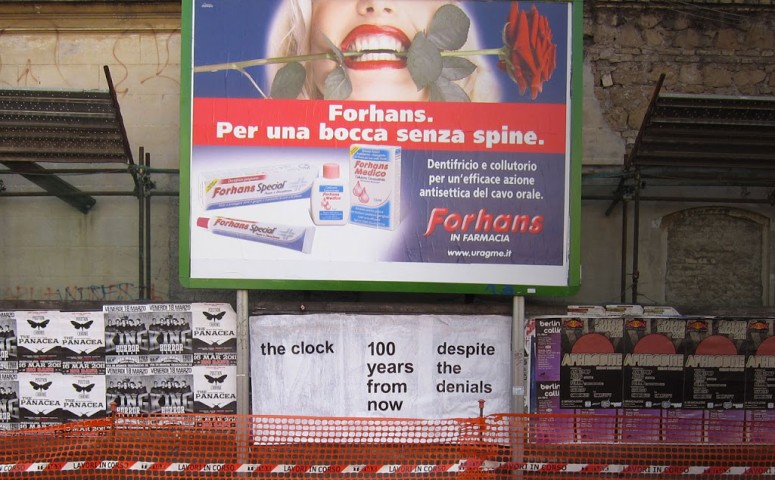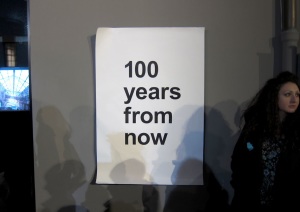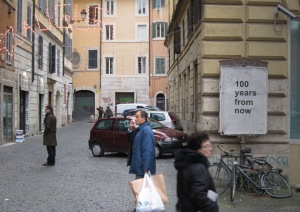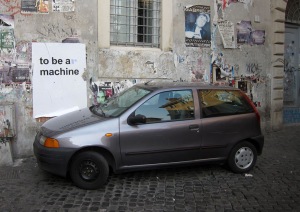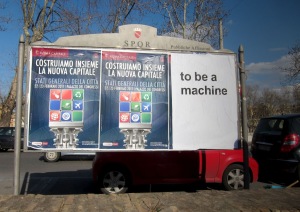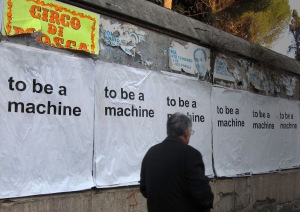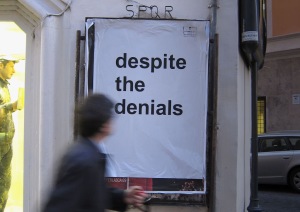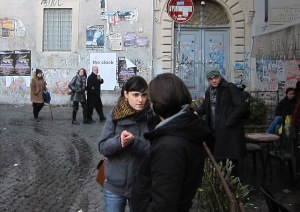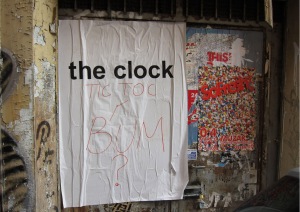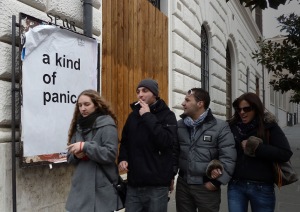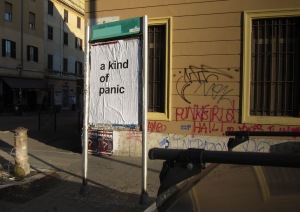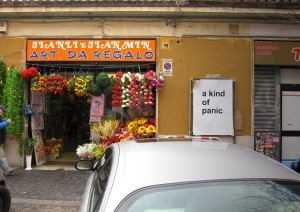Visual artist and designer Jeremy Mende recently returned from spending eight months as a fellow in design at the American Academy in Rome. His project “100 Years from Now” was launched on February 20, 2011, to coincide with the 102nd anniversary of the publication of the original Italian Futurist manifesto. English signs with five phrases were installed in four neighborhoods in Rome, provoking readers to think about their anxious future. The five phrases were:
the clock
to be a machine
despite the denials
100 years from now
a kind of panic
A website (www.100yearsfromnow.info) is part of the project. One of the comments a visitor to the site left a week ago was, “I’ll be dead in a 100 years (hopefully).”
We caught up with Jeremy on his return to find out what he was up to.
Q: What was the essence of the idea you took to the American Academy?
Jeremy Mende: We live in a time where we’re inundated with information that shows how contemporary society is exhausting our resources – peak oil, climate change, extreme water shortages, the population explosion – and yet we seem to be unable to generate any real momentum for societal change. These crises remind us that our global system has limits, yet our lifestyle is based on the assumption of no limits. I think this paradox is generating a growing sense of anxiety about a future that will likely be determined by forces beyond our control. Unlike the Italian Futurists who demonstrated an overwhelming confidence in their vision, our is an uncertain look into the future – a kind of anxious futurism.
The project in Rome was an attempt to capture a sense of this anxiety; to ask the question what is it like to live in a time where critical change is necessary but potentially impossible.
Q: Why is it called “100 Years from Now?”
Mende: It’s impossible to read the phrase and not generate at least a partial vision of the future. At the same time that vision is beyond the reach of any one lifetime so I found that incongruity compelling.
Q: Why the intense interest in the Italian Futurists?
Mende: The values the Futurists celebrated—speed, ego, technology, industrialization, power—still somehow define us. We have a much more ambivalent sense of these things but we are, in many ways, living in a version of the world the Futurist’s dreamed of.
Q: What was your process when you got to the American Academy? What were you doing in that huge studio?
Mende: The work was really a search for a viable visual language. I created a number of form and content studies however it bothered me that as a designer I had no clear context for the work I was making. If I saw what I was doing as “design” there was no client to make use of it, and if I saw what I was doing as “art” there was no gallery to show it.
This ambivalence lead me to look outside the studio for inspiration. In Rome messages on the street are everywhere: inscriptions, signage, advertising, graffiti. It is probably the most written on city in Europe. I began to pay close attention to street advertising and how people interacted with it. I became interested in the possibility of hacking this system. Once I decided the street would be the site many of the other decisions fell into place.
Q: Did any of the people that you met influence the direction of the project?
Mende: The biggest influence came from interacting with writers and poets. The project is really based on the idea of creating poetic fragments that provoke personal interpretation – very, very short poems that refuse to resolve themselves.
Q: When did the idea begin to coalesce?
Mende: The Futurists identified the idea of ambientazione emotiva – that certain forms of visible language, concrete poetry for instance, compel the reader to perform the poem and thereby create a powerful personal space of interpretation. They believed that this type of individual signification happens organically, working on us before the more ‘mechanical’ processes of traditional reading. 100 Years From Now was an attempt to orchestrate a contemporary ambientazione emotiva on the scale of the city.
Q: Did you have dozens of phrases and edit them down to these five?
Mende: Yes, I wrote hundreds of phrases. I was looking for a finite set that would underscore the cultural tensions that I think produce this sense of anxiety. Roughly speaking:
time and time limits
the ever-narrowing space between human and machine
the impossibility of truth in an over-mediated world
visions of the future
a growing undercurrent of anxiety
Q: What is the relationship between the five questions posed on the website and the five statements on the posters?
Mende: The five questions on the site were a way to focus the ambiguous nature of the phrases on the street. For those motivated enough to go to the site I wanted to reward them with a more literal way to get at the bigger ideas that drove the project. For each phrase the site presents a question that adds context.
I was, however, concerned about putting a URL on the signs. It was very important that the signs be as blank as possible. To avoid the need for a URL the individual phrases were tagged in AdWords, Google’s online advertising platform, so that users performing online searches would find announcements for the project in the form of online ads. These ads created an immediate way for users to link directly to the website.
Q: Was this a graffiti kind of project? You just put them up at random spots around Rome? Or was there a map of Rome?
Mende: The installation was highly planned. I worked with the municipality of Rome to produce the project in the four most youth-oriented districts of Rome—Trastevere, Testaccio, Pigneto, and San Lorenzo. These zones have a high concentration of politically engaged, English-speaking, technologically aware people. The municipality supported the project with a cultural grant which allowed me access to a large amount of media space – 1000 placements for 30 days.
Q: Did you go out and observe people’s reactions?
Mende: Yes. The project launched on February 20th – the anniversary of the original 1909 Futurist Manifesto – and ran for 30 days. When the signs first appeared on the street people would do double-takes, and then approach them looking for more information. After the first week the Roman cultural blogs lit up with images and related interpretations of “Il bianchi manifesti” (the white posters), as they came to be called by media. Flickr and Facebook pages were populated with images of the signs and grafittied responses began to appear on the posters themselves. The interpretations on the blogs ran the gamut but in general people read the blank tone as both existential and political; that as much as the issues presuppose an oppositions between the engaged vs. the disengaged, people understood we are simultaneously part of both groups.
In terms of numbers the site recorded 19,000 hits and over 700 comments in 30 days. And as much as there was variety in the responses, three themes came up repeadtedly: a nagging fear that our technological development is coming at the cost of human values like intimacy, and authenticity; faith in the social consciousness of the individual but extreme skepticism as far as governments and commerce; and most disturbingly a sense that real change will only occur as the result of large-scale disaster. This fatalism was one of the larger conclusions – that we are accepting paralysis as a response to the magnitude and complexities of the global issues in front of us.
Q: Given that you are a designer known for striking visuals, why did you decide to use such a minimal graphic approach?
Mende: It was actually very hard to work so minimally. I looked at more formal approaches but these directed the resulting interpretations too much. They either pushed the project into the subjective territory of street art or the commercial zone of advertising. Minimalism was a strategy to project the phrases as pure messages—semantic blocks hanging in space, demanding a reading but refusing to give much away.
Q: The project combines the Web and this old method of street poster. Can you comment on that?
Mende: Contemporary media and technology make it very easy to select what we want to see and what we don’t want to see. Producing the project in real space made it much more difficult to ignore. Multiple exposures worked to penetrate the cognitive firewall we have all learned to construct in order to protect us from messages we find uncomfortable, even if those messages are personally relevant.
Q: Is this project tilting over to art?
Mende: Yes, it is art.
Q: Do you know how this project or your time in Rome might influence your practice once you return to San Francisco?
Mende: I’m increasingly interested in the idea of public interventions. Creating opportunities for people to make positive, personal sense of issues that are determining our world – to realize that they have a vote in the creation ‘the now’– that is empowering, and essential if we want a participatory culture. San Francisco is not Rome and the opportunities for access to outdoor media are much more controlled here. We do, however, have far greater access to technology. I see a version of this project in SF but figuring out the actual/virtual interaction will be more challenging. Billboards are an obvious choice and their authority and monumentality appeal to me, but that will require partnerships that are more difficult to create. Rome proved that cultural, commercial, and civic partnerships can happen, but then they have a very long history of reconciling these interests. My hope is to use the Rome project as an example, and then to build partnerships that allow a more truly interactive version to be produced here.
For more information please visit Jeremy’s website www.mendedesign.com.
